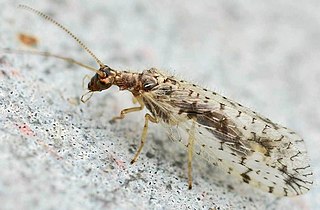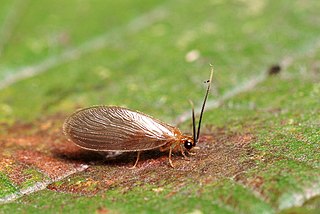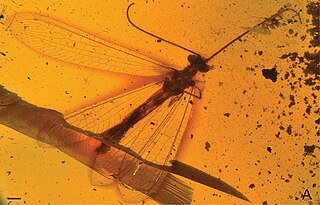
The Crato Formation is a geologic formation of Early Cretaceous (Aptian) age in northeastern Brazil's Araripe Basin. It is an important Lagerstätte for palaeontologists. The strata were laid down mostly during the Aptian age, about 113 million years ago. It thought to have been deposited in a semi-arid lacustrine wetland environment.

The insect order Neuroptera, or net-winged insects, includes the lacewings, mantisflies, antlions, and their relatives. The order consists of some 6,000 species. Neuroptera is grouped together with the Megaloptera and Raphidioptera (snakeflies) in the unranked taxon Neuropterida.

Snakeflies are a group of predatory insects comprising the order Raphidioptera with two extant families: Raphidiidae and Inocelliidae, consisting of roughly 260 species. In the past, the group had a much wider distribution than it does now; snakeflies are found in temperate regions worldwide but are absent from the tropics and the Southern Hemisphere. Recognisable representatives of the group first appeared during the Early Jurassic. They are a relict group, having reached their apex of diversity during the Cretaceous before undergoing substantial decline.

Hemerobiidae is a family of Neuropteran insects commonly known as brown lacewings, comprising about 500 species in 28 genera. Most are yellow to dark brown, but some species are green. They are small; most have forewings 4–10 mm long. These insects differ from the somewhat similar Chrysopidae not only by the usual coloring but also by the wing venation: hemerobiids differ from chrysopids in having numerous long veins and forked costal cross veins. Some genera are widespread, but most are restricted to a single biogeographical realm. Some species have reduced wings to the degree that they are flightless. Imagines (adults) of subfamily Drepanepteryginae mimic dead leaves. Hemerobiid larvae are usually less hairy than chrysopid larvae.

The Berothidae are a family of winged insects of the order Neuroptera. They are known commonly as the beaded lacewings. The family was first named by Anton Handlirsch in 1906. The family consists of 24 genera and 110 living species distributed discontinuously worldwide, mostly in tropical and subtropical regions. Numerous extinct species have also been described. Their ecology is poorly known, but in the species where larval stages have been documented, the larvae are predators of termites.

Sisyridae, commonly known as spongeflies or spongillaflies, are a family of winged insects in the order Neuroptera. There are approximately 60 living species described, and several extinct species identified from the fossil record.
Microberotha is an extinct monotypic genus of "beaded lacewing" in the family Berothidae known from a fossil found in North America. When described the genus contained a single Ypresian-age species Microberotha macculloughi.

The Stenophlebiidae is an extinct family of medium-sized to large fossil odonates from the Upper Jurassic and Cretaceous period that belongs to the damsel-dragonfly grade ("anisozygopteres") within the stem group of Anisoptera. They are characterized by their long and slender wings, and the transverse shape of the discoidal triangles in their wing venation.
Principiala is an extinct genus of lacewing in the moth lacewings family Ithonidae. The genus is known from Cretaceous fossils found in South America, Europe, and possibly Asia. The genus is composed of two species, the type species Principiala incerta, and Principiala rudgwickensis.

Makarkinia is an extinct genus of lacewings in the family Kalligrammatidae described by Martins-Neto in 1997 from fossils found in the Crato Formation of the Araripe Basin in northeastern Brazil. The genus contains three species dating to the Late Aptian, Makarkinia adamsi, Makarkinia kerneri and Makarkinia irmae.

Kalligrammatidae, sometimes known as kalligrammatids or kalligrammatid lacewings, is a family of extinct insects in the order Neuroptera (lacewings) that contains twenty genera and a number of species. The family lived from the Middle Jurassic to the early Late Cretaceous before going extinct. Species of the family are known from Europe, Asia, and South America. The family has been occasionally described as "butterflies of the Jurassic" based on their resemblance to modern butterflies in morphology and ecological niche.
Araripenymphes is an extinct genus of lacewing in the family Nymphidae known from fossils found in the Crato Formation of the Araripe Basin in South America. The genus contains a single species, Araripenymphes seldeni. The genus was named after the basin.
Burmaleon is an extinct genus of lacewing in the family Osmylidae known from fossils found in Asia. The genus contains a single species, Burmaleon magnificus.

The Araripe Basin is a rift basin covering about 8,000 square kilometres (3,100 sq mi), in Ceará, Piauí and Pernambuco states of northeastern Brazil. It is bounded by the Patos and Pernambuco lineaments, and is situated east of the Parnaíba Basin, southwest of the Rio do Peixe Basin and northwest of the Tucano and Jatobá Basins.
Prosisyrina is an extinct genus of lacewing in the neuropteran family Sisyridae. The genus contains two described species, Prosisyrina sphinga and Prosisyrina sukachevae. Prosisyrina is known from a group of Late Cretaceous fossils which were found in Asia.

The Santana Group is a geologic group, formerly included as the middle part of the Araripe Group, in the Araripe Basin of northeastern Brazil. The group comprises the Crato, Ipubi and Romualdo Formations and is dated to the Aptian to Albian stages of the Early Cretaceous. The formations of the group were deposited in a lacustrine to subtidal shallow marine environment in the Araripe rift basin.
2017 in paleoentomology is a list of new fossil insect taxa that were described during the year 2017, as well as other significant discoveries and events related to paleoentomology that were scheduled to occur during the year.
2015 in paleoentomology is a list of new fossil insect taxa that were described during the year 2016, as well as other significant discoveries and events related to paleoentomology that were scheduled to occur during the year.
Burmese amber is fossil resin dating to the early Late Cretaceous Cenomanian age recovered from deposits in the Hukawng Valley of northern Myanmar. It is known for being one of the most diverse Cretaceous age amber paleobiotas, containing rich arthropod fossils, along with uncommon vertebrate fossils and even rare marine inclusions. A mostly complete list of all taxa described up until 2018 can be found in Ross 2018; its supplement Ross 2019b covers most of 2019.

Babinskaiidae is an extinct family of neuropterans known from the Cretaceous period. They are part of the superfamily Myrmeleontoidea. Their distinguishing characters include: "long filiform antennae, narrowly elongated wings, with features such as trichosors, and presectorial cross veins present in both wings, and absence of forewing oblique vein". They are considered transitional between Nymphidae and more derived myrmeleontodoids, such as antlions.










